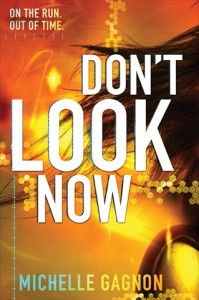I am very excited to have Michelle Gagnon as my guest, but she is definitely no stranger to TKZ. Many of you know Michelle was a former contributor extraordinaire to our blog and I’m excited to hear her thoughts on trilogies and her latest release. Welcome, Michelle!
Hi folks, I’ve missed you! So good to be back on TKZ.
With the success of The Girl with the Dragon Tattoo and The Hunger Games, trilogies are all the rage these days. In fact, when I first pitched an idea for a young adult novel to my publisher, they specifically requested a trilogy. I agreed, because hey, what author wouldn’t want to guarantee the publication of three more books? Besides, I’d written a series before. How much harder could a trilogy be?
The first one, DON’T TURN AROUND, turned out to be the easiest book I’ve ever written. The rough draft flowed out of me in eight weeks; it was one of those magical manuscripts that seemed to write itself.
I sat back down at the computer, confident that the second and third would proceed just as smoothly; even (foolishly) harboring hopes that I’d knock the whole thing out in under six months.
Boy, was I wrong.
Here’s the thing: in a regular series, even though the characters carry through multiple books (and occasionally, plotlines do as well), they’re relatively self-contained. In the end, the villain is (usually) captured or killed; at the very least, his evil plan has been stymied.
Not so in a trilogy. For this series, I needed the bad guy—and the evil plot—to traverse all three books. Yet each installment had to be self-contained enough to satisfy readers.
Suffice it to say that books 2 and 3 were a grueling enterprise. But along the way, I learned some important lessons on how to structure a satisfying trilogy:
- Each book has its own arc. Well, that’s obvious, right? But what this really means is that book 3 can’t feel like a mere continuation of book 2. Even if your villain/evil plot spans all three books, you need to provide resolution at the end of each installment. This is a good place to employ what I’ve dubbed, “The Henchman Rule.” At the end of each book, someone needs to be held accountable; otherwise your hero/heroine won’t seem to be making any headway. And the best solution for this? Get rid of the main baddie’s number 2, his right hand man. My favorite example is the stripping of Saruman’s powers at the end of The Two Towers. Sauron must wait to be dealt with in The Return of the King, but his main wizard is handily dispatched by Gandalf (suffice it to say, I didn’t have much of a social life in junior high school).
- Avoid “Middle Book Syndrome.” What I discussed above is particularly challenging in the second book of any trilogy. This is the bridge book, the one where the characters need to move forward in their quest, but not too far forward. Traditionally, this is also the book that concludes with your main character (or characters) beaten down, exhausted, and uncertain of the possibility of success. Which can be a pretty depressing note to end on, unless you also provide them with a key: something that will help them surmount obstacles in book 3. That key can be any number of things: more information about the evil plan, the villain’s only vulnerability, etc. But the main goal is to set the stage for book 3, while still wrapping up enough threads to keep your readers happy.
- Character arcs need to span all three books. In a standalone, the main character faces some sort of incident that jettisons her into extreme circumstances (ie: Katniss’s sister losing the lottery). An escalation of events follows: the character is forced to confront her own weaknesses, and to discover her hidden strengths. At the end of Act 2, the character is usually at a low point, facing potential failure. Then, in the final act, the character rises to the occasion and ends up saving the day. In a trilogy, these same rules apply: but the conclusion of each book corresponds with the act breaks. Example: at the end of The Girl who Played with Fire (#2 in the trilogy), Lisbeth is horribly injured; she needs to overcome that incapacitation in order to finally vanquish her father in book 3.
- Avoid information dumps. Always a good rule, but trickier with trilogies. While working on the final installment, I kept butting up against this issue: when characters referred back to earlier events, how much background information was necessary to keep readers from becoming irrevocably lost? In the end, I provided very little. The truth is, it’s rare for people to start with the third book in a trilogy; I’m sure it happens, but it’s the exception, not the rule. So what you’re really doing is giving gentle reminders to people who might have read the last book months earlier. Provide enough information to jog their memory, without inundating them. It’s a tricky balance to strike, but I’d recommend erring on the side of giving less, not more.
So those are my tips, earned the hard way. Today’s question: what trilogies (aside from those I mentioned) did you love, and what about them kept you reading?
 Michelle Gagnon is the international bestselling author of thrillers for teens and adults. Described as “The Girl with the Dragon Tattoo meets the Bourne Identity,” her YA technothriller DON’T TURN AROUND was nominated for a Thriller Award, and was selected as one of the best teen books of the year by Entertainment Weekly Magazine, Kirkus, Voya, and the Young Adult Library Services Association. The second installment, DON’T LOOK NOW, is on sale now (and hopefully doesn’t suffer from “middle book syndrome.”) She splits her time between San Francisco and Los Angeles.
Michelle Gagnon is the international bestselling author of thrillers for teens and adults. Described as “The Girl with the Dragon Tattoo meets the Bourne Identity,” her YA technothriller DON’T TURN AROUND was nominated for a Thriller Award, and was selected as one of the best teen books of the year by Entertainment Weekly Magazine, Kirkus, Voya, and the Young Adult Library Services Association. The second installment, DON’T LOOK NOW, is on sale now (and hopefully doesn’t suffer from “middle book syndrome.”) She splits her time between San Francisco and Los Angeles.

